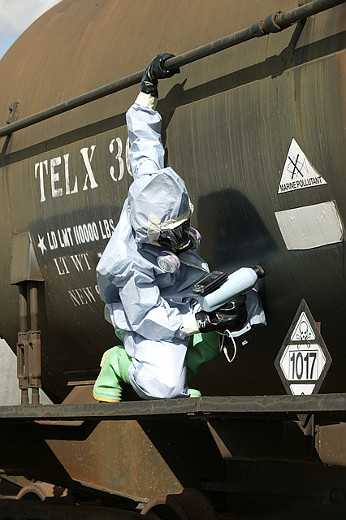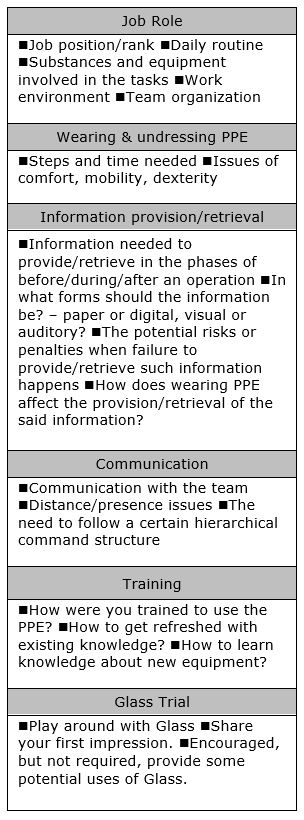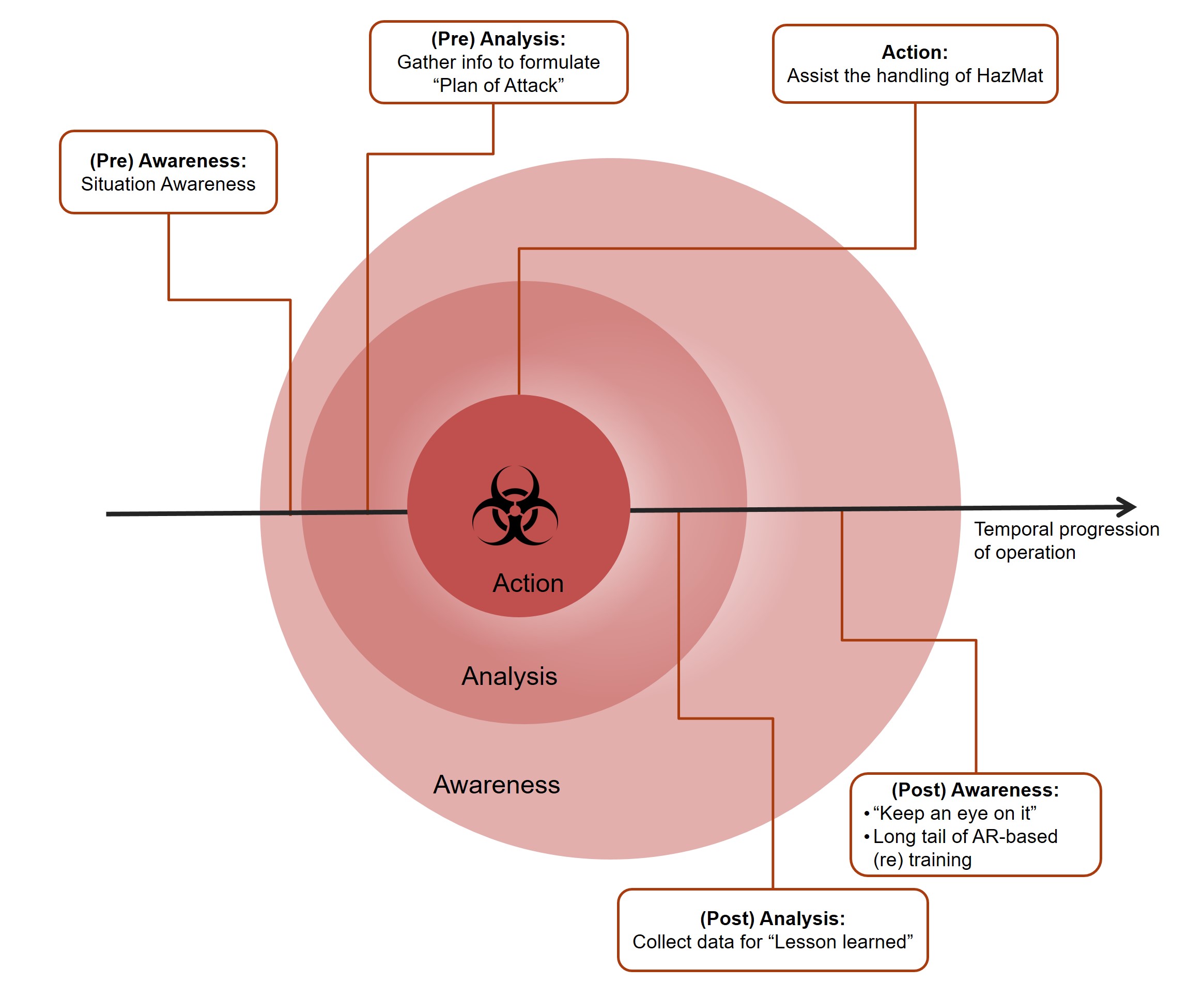Contextual Inquiry: Google Glass for Bio-Hazard Handling Professionals
(I started and worked on this research when I was a PhD Interaction Intern at PNNL - Pacific Northwest National Laboratory.)
Firefighters, bomb squads, or bio-medical first responders, these professionals (the “heroes”) have one thing in common: They wear bulky and heavy PPE (Personal Protective Equipment) while handling unknown, complex, and even deadly hazardous materials (HazMat). The PPE (e.g., mask, suit, gloves, oxygen tank, etc.), along with other equipment such as portable chemical detectors and communications devices, are meant to help the HazMat handling professionals’ missions. However, they may also pose limitations and even hindrances when the heroes make life-or-death decisions.
To investigate the design opportunities for using Google Glass to support these heroes, I conducted a series of contextual inquiry with 6 HazMat handling professionals. They were first responders (firefighters), industrial health specialists, and epidemiologists. They all shared the experiences of wearing PPE and carrying HazMat tools, while conducting their inspection and threat-neutralizing tasks. Some of the interviewed participants were in managerial positions who oversaw and organized biohazard response operations.
The contextual inquiry’s main goal was to understand the challenges they faced during their work. A small part of the interviews were allotted for them to try Google Glass. Then, we encouraged them to share their first impressions about Google Glass and its potential relevance or applications to their work.
Using inductive thematic analysis, I synthesized 4 “Heroes’ Problems”: Fear for the Unknown; Limited Dexterity; Communication & Information Insufficiencies; and (Re) Training. Then, I generated an A3 model to summarize Google Glass design opportunities that may be useful those HazMat handling, PPE-wearing professionals’ work: (Pre) Awareness; (Pre) Analysis; Action; (Post) Analysis; and (Post) Awareness.
Project Background:
This research was conducted as a part of my 2014 PhD Interaction Research Internship at PNNL (Pacific Northwest National Laboratory). Initially, I was given a Google Glass to come up with potential use case(s). After literature review and background review, I generated several design possibilities in different fields. Eventually, we decided to proceed with the direction of using Google Glass to support PPE-wearing and HazMat handling professionals because it was a very under-explored topic.
My big thanks to the PNNL scientists who gave me the freedom to lead the research while supporting me with mentoring and resources.
Other Info:
Firefighters, bomb squads, or bio-medical first responders, these professionals (the “heroes”) have one thing in common: They wear bulky and heavy PPE (Personal Protective Equipment) while handling unknown, complex, and even deadly hazardous materials (HazMat). The PPE (e.g., mask, suit, gloves, oxygen tank, etc.), along with other equipment such as portable chemical detectors and communications devices, are meant to help the HazMat handling professionals’ missions. However, they may also pose limitations and even hindrances when the heroes make life-or-death decisions.

A PPE-wearing professional using a detector for HazMat (image courtesy of PNNL)
To investigate the design opportunities for using Google Glass to support these heroes, I conducted a series of contextual inquiry with 6 HazMat handling professionals. They were first responders (firefighters), industrial health specialists, and epidemiologists. They all shared the experiences of wearing PPE and carrying HazMat tools, while conducting their inspection and threat-neutralizing tasks. Some of the interviewed participants were in managerial positions who oversaw and organized biohazard response operations.
The contextual inquiry’s main goal was to understand the challenges they faced during their work. A small part of the interviews were allotted for them to try Google Glass. Then, we encouraged them to share their first impressions about Google Glass and its potential relevance or applications to their work.

Interview questions used for the contextual inquiry
Using inductive thematic analysis, I synthesized 4 “Heroes’ Problems”: Fear for the Unknown; Limited Dexterity; Communication & Information Insufficiencies; and (Re) Training. Then, I generated an A3 model to summarize Google Glass design opportunities that may be useful those HazMat handling, PPE-wearing professionals’ work: (Pre) Awareness; (Pre) Analysis; Action; (Post) Analysis; and (Post) Awareness.

The A3 Model
(summarizing proposed Google Glass features for PPE-wearing, HazMat-handling professionals)
Project Background:
This research was conducted as a part of my 2014 PhD Interaction Research Internship at PNNL (Pacific Northwest National Laboratory). Initially, I was given a Google Glass to come up with potential use case(s). After literature review and background review, I generated several design possibilities in different fields. Eventually, we decided to proceed with the direction of using Google Glass to support PPE-wearing and HazMat handling professionals because it was a very under-explored topic.
My big thanks to the PNNL scientists who gave me the freedom to lead the research while supporting me with mentoring and resources.
Other Info:
- Funding Agency: DTRA (Defense Threat Reduction Agency) (part of Department of Defense), USA
- Project conducted at PNNL (Pacific Northwest National Laboratory), USA
- Jack Shen-Kuen Chang, Michael J. Henry, Russ Burtner, Oriana Love, and Courtney Corley. "The Heroes' Problems: Exploring the Potentials of Google Glass for Biohazard Handling Professionals." In Proceedings of the 33rd Annual ACM Conference Extended Abstracts on Human Factors in Computing Systems (CHI EA '15), pp. 1531-1536. ACM, 2015. [pdf] / [pub]
(PNNL Scientists)
- Michael J. Henry
- Russ Burtner
- Courtney Corley
